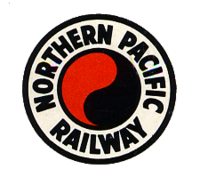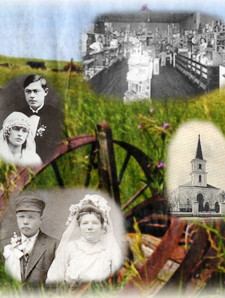» posted on Tuesday, August 21st, 2012 by Linda Lou Burton
Enticements
 Linda Burton posting from Bismarck, North Dakota – I got a mouthful of information from City Portrait on Bismarck’s official website. It says “On July 17, 1873, Bismarck was named in honor of Germany’s “Iron Chancellor” Prince Baron Otto Eduard Leopold Von Bismarck-Schoenhausen, a famous German statesman from Prussia, credited with the creation of the German Empire and serving as her first chancellor.” I wanted to make the connection between Bismarck’s name and the area around Bismarck known as “the German-Russian Triangle.” It’s also called the “Sauerkraut Triangle,” and is one of the most homogeneous ethnic German-Russian enclaves in existence today; in six North Dakota counties at least 75 percent of the people claim German ancestry. So, why was Bismarck named Bismarck? It’s a story of enticement, and railroads.
Linda Burton posting from Bismarck, North Dakota – I got a mouthful of information from City Portrait on Bismarck’s official website. It says “On July 17, 1873, Bismarck was named in honor of Germany’s “Iron Chancellor” Prince Baron Otto Eduard Leopold Von Bismarck-Schoenhausen, a famous German statesman from Prussia, credited with the creation of the German Empire and serving as her first chancellor.” I wanted to make the connection between Bismarck’s name and the area around Bismarck known as “the German-Russian Triangle.” It’s also called the “Sauerkraut Triangle,” and is one of the most homogeneous ethnic German-Russian enclaves in existence today; in six North Dakota counties at least 75 percent of the people claim German ancestry. So, why was Bismarck named Bismarck? It’s a story of enticement, and railroads.
 The vision of building a transcontinental railroad was not attracting the investors it needed. Henry Villard, who was Secretary of Northern Pacific Railroad at the time, had an idea. He drew up a map of the townsite on the east bank of the Missouri River that had a large population of German immigrants. The townsite was given the name of Germany’s chancellor and the map was shown all over Europe. The hope was that Chancellor Bismarck would send a few Reichsmarks to help the small metropolis get on its feet. Alas, he did not send money, but he did send a thank you note! Still, the name Bismarck stuck.
The vision of building a transcontinental railroad was not attracting the investors it needed. Henry Villard, who was Secretary of Northern Pacific Railroad at the time, had an idea. He drew up a map of the townsite on the east bank of the Missouri River that had a large population of German immigrants. The townsite was given the name of Germany’s chancellor and the map was shown all over Europe. The hope was that Chancellor Bismarck would send a few Reichsmarks to help the small metropolis get on its feet. Alas, he did not send money, but he did send a thank you note! Still, the name Bismarck stuck.
 It’s a fitting name for this capital city, in a state whose ancestry group is 47 percent German. Throughout the latter half of the nineteenth century and into the twentieth century, North Dakota was a popular destination for immigrant farmers and their families. North Dakota is well known for its fertile lands; it is one of the richest farming regions in North America.
It’s a fitting name for this capital city, in a state whose ancestry group is 47 percent German. Throughout the latter half of the nineteenth century and into the twentieth century, North Dakota was a popular destination for immigrant farmers and their families. North Dakota is well known for its fertile lands; it is one of the richest farming regions in North America.
About 100,000 Germans immigrated to the United States by 1900; by 1910, about 60,000 Germans from Russia lived in central North Dakota. Thus the “triangle” – an area extending from Wishek west to Elgin and north to Harvey, with Bismarck right in the middle. By 1920, the Dakota Freie Presse reported that North Dakota had 23 percent of the entire German-Russian population of the United States.
Other European immigrants that settled in North Dakota, mostly in the northeastern corner of the state, came from Norway; ethnic Norwegians make up 31 percent of North Dakota’s total population. Today three out of four residents of North Dakota are descended from German and Norwegian pioneers who arrived as farmers in the growth years of 1880-1914.
 And they come from Europe now as tourists; just today, I encountered a tour bus filled with Norwegian travelers, stopping to eat in a local German restaurant. Peruse the North Dakota tourism website to see native language marketing messages directed to travelers in Denmark, Finland, Germany, Iceland, Norway, and Sweden. Do you think Baron Von Bismarck might be enticed to come in this day and age?
And they come from Europe now as tourists; just today, I encountered a tour bus filled with Norwegian travelers, stopping to eat in a local German restaurant. Peruse the North Dakota tourism website to see native language marketing messages directed to travelers in Denmark, Finland, Germany, Iceland, Norway, and Sweden. Do you think Baron Von Bismarck might be enticed to come in this day and age?
About Bismarck, City Portrait http://www.bismarck.org/index.aspx?NID=642
About North Dakota Tourism http://www.ndtourism.com/international/welcome/
